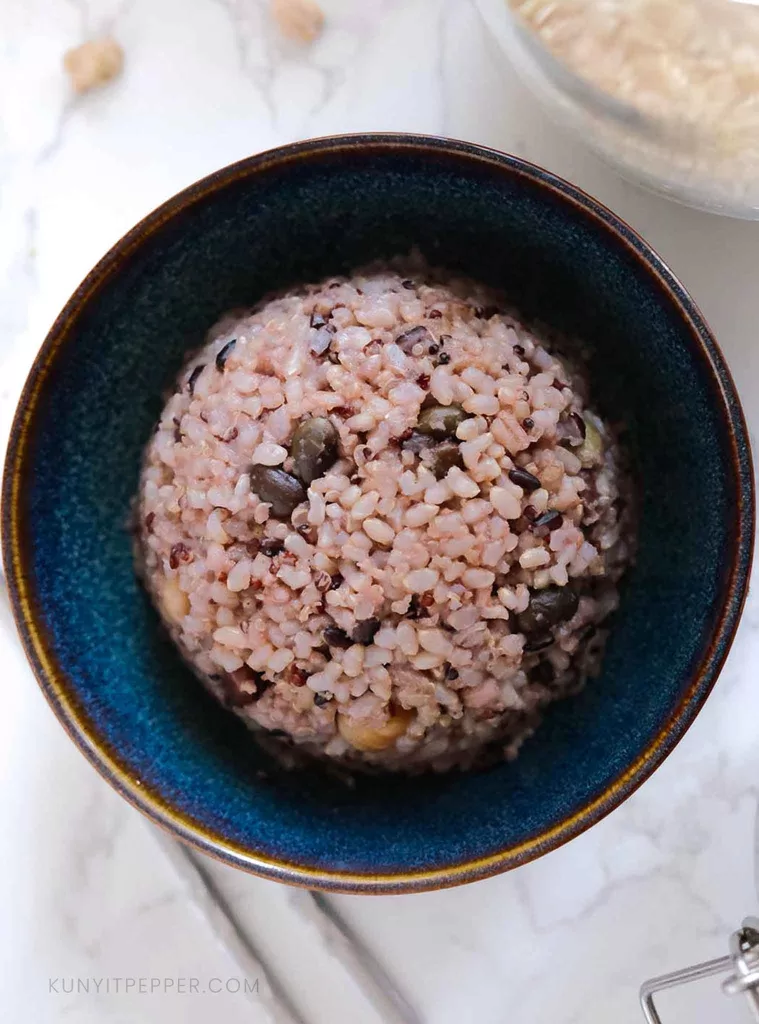
About this Korean multigrain rice recipe in a rice cooker
Japgokbap has been my go-to healthy rice dish with legumes, that I often meal-prep. Cooking this multigrain rice in a rice cooker makes it easy to enjoy a variety of whole grains and legumes in one pot. It’s an effortless way to eat variety of plant-based foods in 1 bowl.
What is Japgokbap (Korean Multigrain Rice)
Japgokbap is a mix of rice, whole grains, and legumes (some variations even include vegetables), often cooked together in 1 pot for extra nutrition, texture, and flavor. It’s a traditional Korean rice, a nutritious carb to eat alongside other sides (Banchan) and main courses.
Table of Contents
- About this Korean multigrain rice recipe in a rice cooker
- What is Japgokbap (Korean Multigrain Rice)
- Watch how I cook Japgokbap in a rice cooker
- My Korean multigrain rice snippet
- Health benefits of Korean multigrain rice
- Japgokbap recipe ingredients (notes & substitutions)
- How to Cook Multigrain Rice in a Rice Cooker
- Cook Korean multigrain rice without soaking the legumes overnight!
- Benefits of soaking legumes?
- Tips & important notes
- Storage guide
- Reheating guide
- FAQ
As someone who follows a healthy Asian diet focused on real, antioxidant-rich ingredients, I appreciate how traditional Korean food makes everyday staples more nutritious.
This simple practice of combining legumes and grains not only makes the rice rich in fiber and protein but also increases its overall nutritional value.
Watch how I cook Japgokbap in a rice cooker
My Korean multigrain rice snippet
This Korean multigrain rice recipe is simple to make using a rice cooker. You can choose to soak overnight or same-day soaking.
The recipe combines eight whole grains and legumes: short-grain brown rice, black rice, barley, millet, quinoa, adzuki beans, black beans, and chickpeas. I mix them in a 2:1:1 ratio of rice, grains, and beans, for a hearty, balanced, high-fiber mix.

Health benefits of Korean multigrain rice
- Variety of plant-based ingredients in one bowl – This multigrain rice isn’t just rich in fiber, protein, antioxidants, and minerals. It’s also a simple way to eat more plant-based foods. Research shows that eating more plant-based foods can improve gut health, lower cholesterol, lead to better heart health, improve blood sugar control, and reduce inflammation.
- It’s a nutritious choice of carbohydrate. 1 bowl of Korean multigrain rice contains:
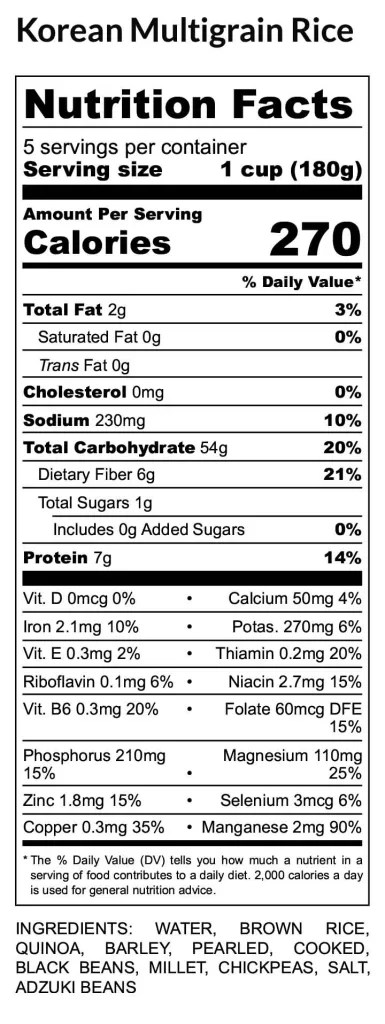
- Rich in antioxidant properties – Legumes and grains are rich in antioxidant properties (1,2). These plant-based compounds help reduce everyday damage (stress, sleepless, alcohol etc) that can build up over time, which may help lower the risk of chronic diseases (3). Some common antioxidants in this multigrain rice include polyphenols (such as flavonoids and anthocyanins), phenolic acids, and vitamin E.
- Lower in Glycemic Index – Because of the fiber and protein in the whole grains and legumes, Japgokbap is lower on the glycemic index (GI) (4, 5). It means the carbohydrates turn to sugar slowly, causing a slow rise rather than a high spike in blood sugar levels compared to when eating simple carbs like white rice and white bread.
According to an article about whole grains on Harvard,
Replacing refined grains with whole grains and eating at least two servings of whole grains daily may help reduce type 2 diabetes risk (6).
- Gut-Friendly – Some whole grains, such as barley and legumes, contain prebiotics (7). They promote diversity of gut bacteria and healthy bowel movements, which contribute to overall health (8).
☝️ Note: Though it can be healthy, multigrain rice contains starch and carbohydrates that will become sugar. The best rule of thumb is to keep it in moderation and eat it alongside other dishes like vegetables.
Japgokbap recipe ingredients (notes & substitutions)
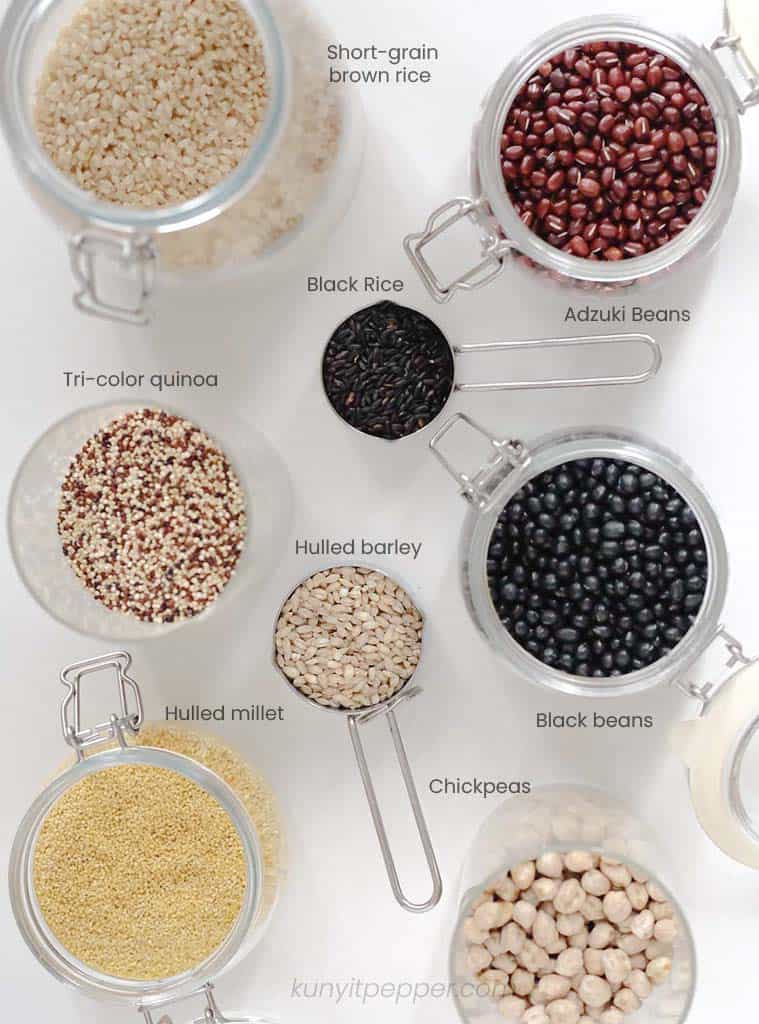
WHOLE GRAINS
- Short-grain brown rice – I use short-grain brown rice for a whole grain option. You can also opt for short-grain white rice, which is used in sushi.
- Black rice/Forbidden rice – This is a secondary rice, used in small amounts compared to brown rice. This black rice is what makes the rice purple in Korean purple rice.
- Quinoa – I use a tri-color option for more antioxidants and fiber content. I understand that black quinoa can taste bitter to some, so feel free to use regular quinoa.
- Barley – If you are gluten intolerant, consider skipping or swapping this ingredient for amaranth and oat.
- Millet – I use a foxtail millet. Another millet commonly used in Korean multigrain rice is proso millet.
LEGUMES (Dried)
- Chickpeas – I use dried chickpeas in this recipe.
- Black Beans – You can also use black soybeans!
- Adzuki Beans – These small red beans are often confused with kidney beans, which are larger and take much longer to cook. Avoid using kidney beans as they won’t cook at the same time as the other ingredients in this recipe.
SEASONING
- Salt
How to Cook Multigrain Rice in a Rice Cooker
Step 1. Soaking the legumes
Soak all the beans in water overnight for 12 hours. Make sure they sink to the bottom.
Since I use all dried ingredients, soaking them overnight gives time to absorb enough water so they cook at the same time as the grains in the rice cooker. If you prefer to cook on the same day, jump below for an option without overnight soaking.
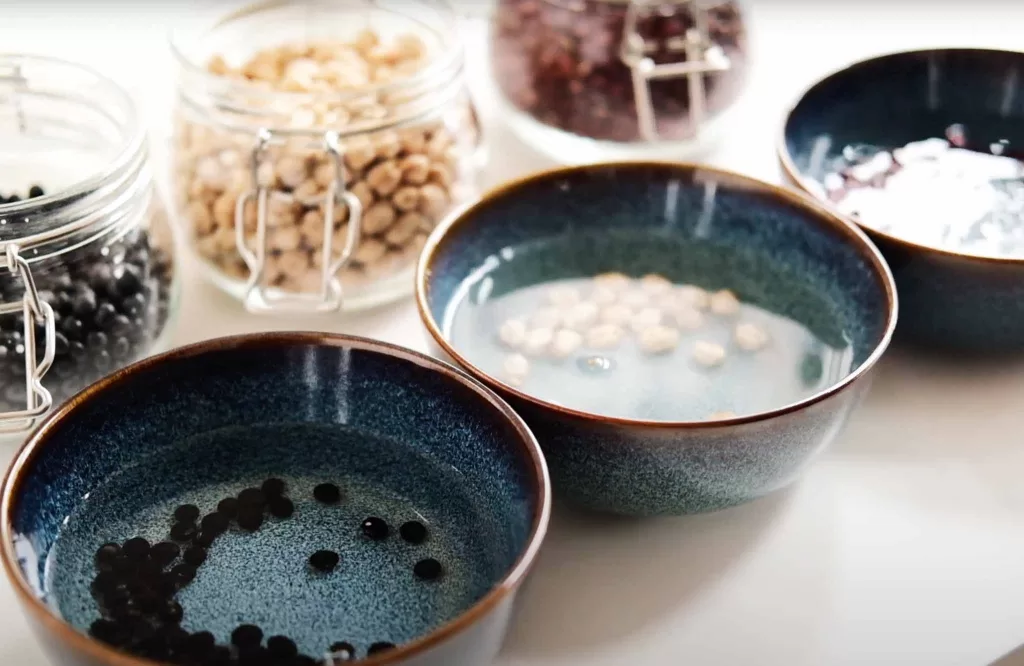
Step 2. Rinse and soak the whole grains (1 hour)
The following day, an hour before the beans are ready, mix the grains and rice in a bowl. Rinse them until the water runs clear, and soak for an hour. ☝️ Soaking brown rice and black rice is necessary.
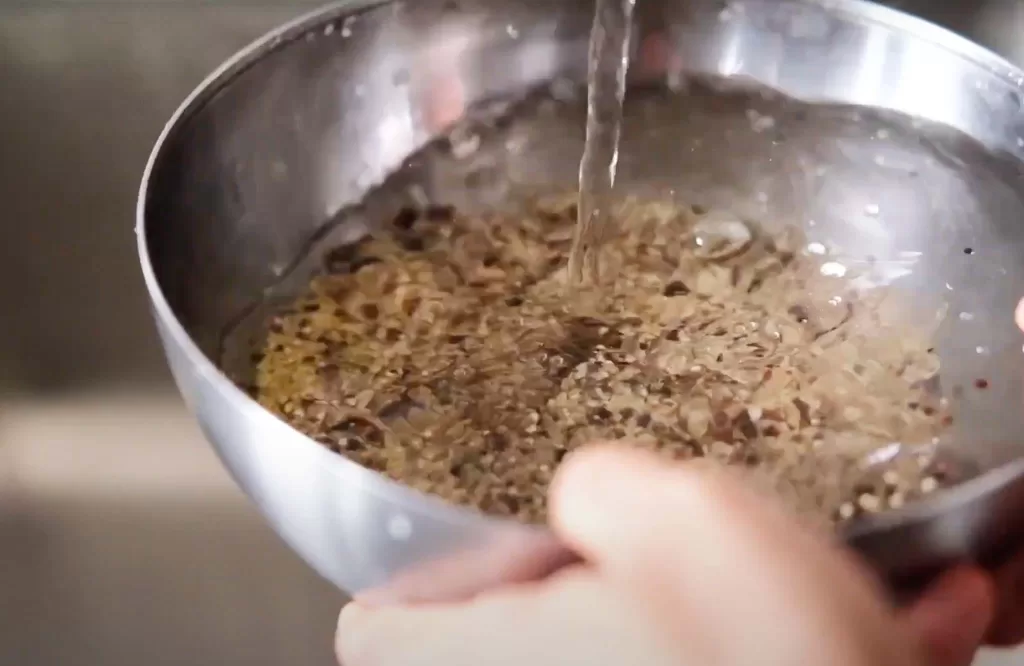
Step 3. Mix them all in a pot to cook
Drain the water from the mixed grains and beans, rinse them over a fine mesh strainer, and transfer them to the rice cooker pot. Add water and salt and it’s ready to cook.
You can use a manual setting by setting it to cook for 1 hour, or use the brown rice setting if you have (this is what I do). If you only have a regular rice setting, consider cooking 2 times.

Cook Korean multigrain rice without soaking the legumes overnight!
If the thought of soaking beans overnight bothers you, there are a couple of ways to cook them faster.
- Use canned beans and chickpeas. You can use kidney beans in this recipe if you use canned beans. Just skip to step 2 and reduce the water by 1 cup when adding the water to the pot.
- Pressure cook the beans and chickpeas in an Instant Pot. Before you start step 2, set the beans and chickpeas to Pressure Cook on High for 25 minutes (without soaking) and 15 minutes (if soaking for 4h). Remember to reduce the water by 1 cup when cooking, mixing the cooked legumes in a rice cooker.
Benefits of soaking legumes?
Soaking legumes is a personal preference. Here’s why I prefer to soak the legumes.
1. Reduce the amount of lectin in the beans that cause bloating.
Lectin is a type of anti-nutrient that is found in grains and legumes. Some people (like my husband and I) can react to lectins, such as bloating. Scientifically, soaking the beans may help reduce lectin sensitivity and anti-nutrient activity. Physically, with soaked legumes, my tummy feels less odd and not as gassy.
2. Reduce the Phytic acid / Phytate concentration of beans. This results in increasing the ability of our body to absorb certain minerals.
Phytic acid is an anti-nutrient as it can block the absorption of some minerals into the body. It means your body won’t be able to absorb minerals like Calcium, Magnesium, Iron, Zinc, and Manganese when you eat foods with high Phytic acid (Beans). Soaking legumes helps reduce phytate and increases the absorption of minerals.
3. Reduce the cooking time.
Based on my experience in making this multigrain rice countless times, the longer you soak the beans (12 hours), the shorter the time they take to cook and soften (1 hour).
Tips & important notes
- Try to get organic ingredients or as natural as you can. Many grains, nuts, and legumes have been exposed to pesticides, herbicides, and fungicides that can be harmful.
- Brown rice and black rice are whole grains. Which means they need more water to absorb, and take longer to cook. Pre-soaking them for 1 hour is important to reduce the cooking time in the rice cooker and ensure fluffy rice.
Storage guide
Store the multigrain rice in a container in the fridge for up to 3 days. For longer storage, divide it into individual portions and store them in a freezer. These can last up to a month!
Reheating guide
To reheat in the microwave, bring your individual portions out to defrost an hour before your meal time and reheat them when ready. Or if you have a microwave with a defrost function, you can do that.
To reheat without a microwave, consider steaming them in a steaming pot or basket for 5-10 minutes.
FAQ
Do I need to soak the beans and grains when making multigrain rice?
Yes, soaking grains and legumes can help to reduce cooking time, ensure they cook evenly, and improve digestion. If you want to skip soaking, you can cook legumes first in a pressure cooker before mixing them in a rice cooker.
What’s the ideal rice-to-grains-and-legumes ratio when making multigrain rice?
This Korean multigrain rice ratio is 2:1:1. That is 1 cup of rice, 1/2 cup of grains, and 1/2 cup of beans.
Can I use canned beans instead of dried?
Absolutely. Canned beans help save time when preparing, as you don’t need to soak prior to cooking. You can also use canned chickpeas!
How long does multigrain rice last in the fridge?
Multigrain rice can last in the fridge up to 3 days. If you want to keep it longer, consider freezing it.
Korean multigrain rice in a rice cooker – Japgokbap
5
pax12
hours1
hour270
kcal13
hoursJapgokbap is a traditional Korean rice that mixes rice, whole grains, and legumes, cooked together in 1 pot for extra nutrition, texture, and flavor. This recipe uses a rice cooker.
Ingredients
- Legumes
1 heaped tbsp Adzuki beans
1 heaped tbsp black beans
1 heaped tbsp chickpeas
- Grains
1 rice cooker cup short-grain brown rice
1 tbsp black rice
2 tbsp barley (Amaranth or oat for gluten-free option)
2 tbsp foxtail millet
2 tbsp tri-color quinoa
- Water and salt
3 and 1/2 rice cooker cups water
1/2 tsp salt
Directions
- Soak the legumes in water overnight for 12 hours, making sure they sink to the bottom. Jump above if you want to skip overnight soaking.
- On the following day, an hour right before the beans are ready, mix all the grains and rice in a bowl or rice cooker pot, rinse until the water runs clear, and leave them to soak for an hour.
- Drain the water from the mixed grains and beans, rinse them, and transfer them to the rice cooker pot.
- Add water and salt, and it’s ready to cook, depending on the type of rice cooker you have.
I- You can use a manual setting by setting it to cook for 1 hour.
II- Use the brown rice setting if you have (this is what I do).
III- If you only have a regular rice setting, consider cooking for 2 rounds.
Rice cooker (the closest model to what I use in this recipe)
- Zojirushi Multifunction Rice CookerCheck on Amazon
Recipe Video
Nutrition Facts
- Serving Size: 180g
- Total number of serves: 5
- Calories: 270kcal
- Fat: 0g
- Cholesterol: 0mg
- Sodium: 230mg
- Carbohydrates: 54g
- Fiber: 6g
- Sugar: 1g
- Protein: 7g
- Calcium: 50mg
- Iron: 2.1mg
- Vitamin E: 0.3mg
- Thiamin: 0.2mg
- Niacin: 2.7mg
- Vitamin B6: 0.3mg
- Folate: 60mg
- Zinc: 1.8mg
- Copper: 0.3mg
- Manganese: 2mg
🥣 Did you try this recipe? Let me know your thoughts in the comments below.

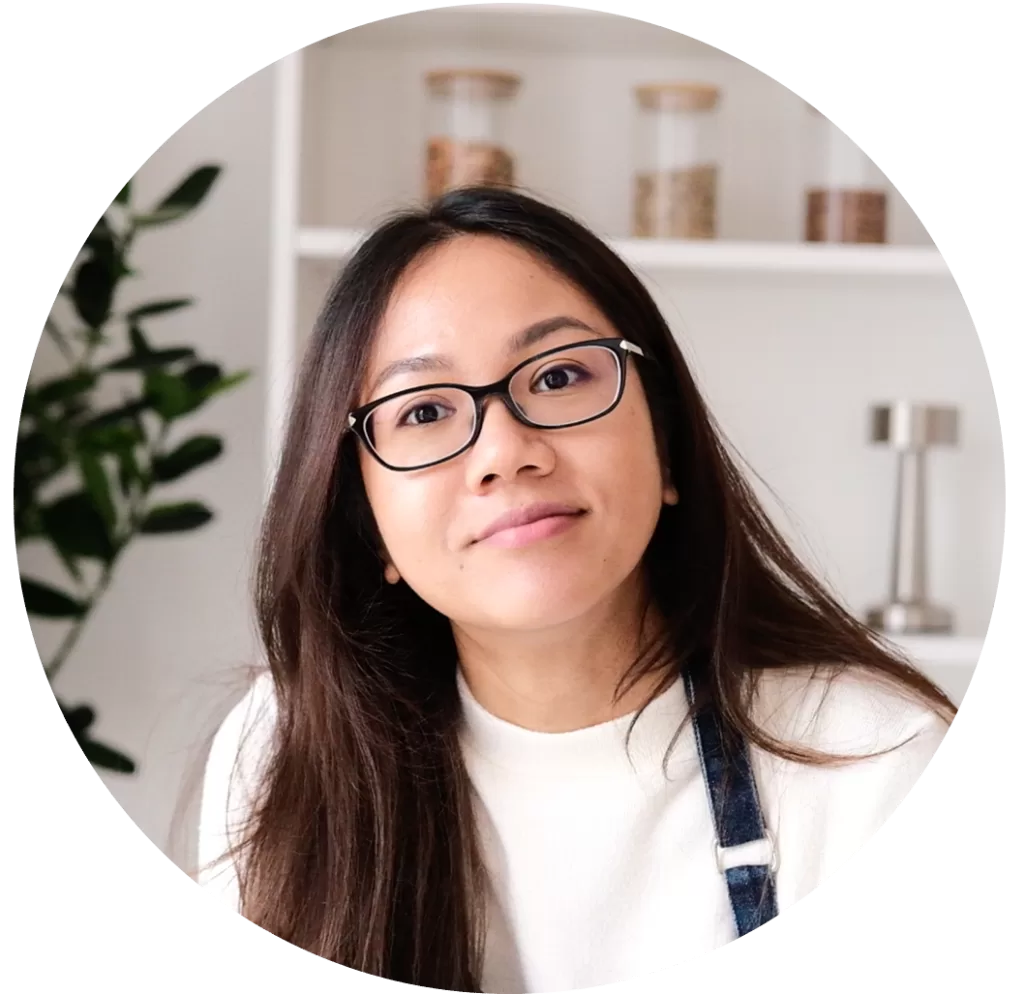
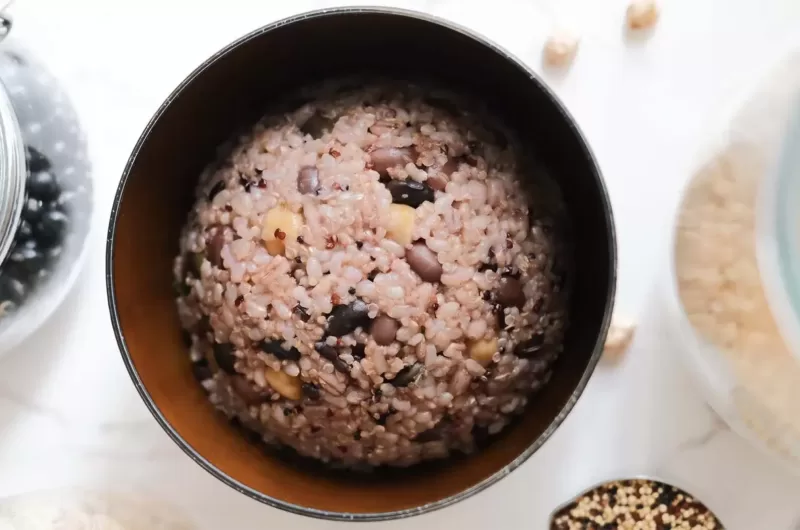
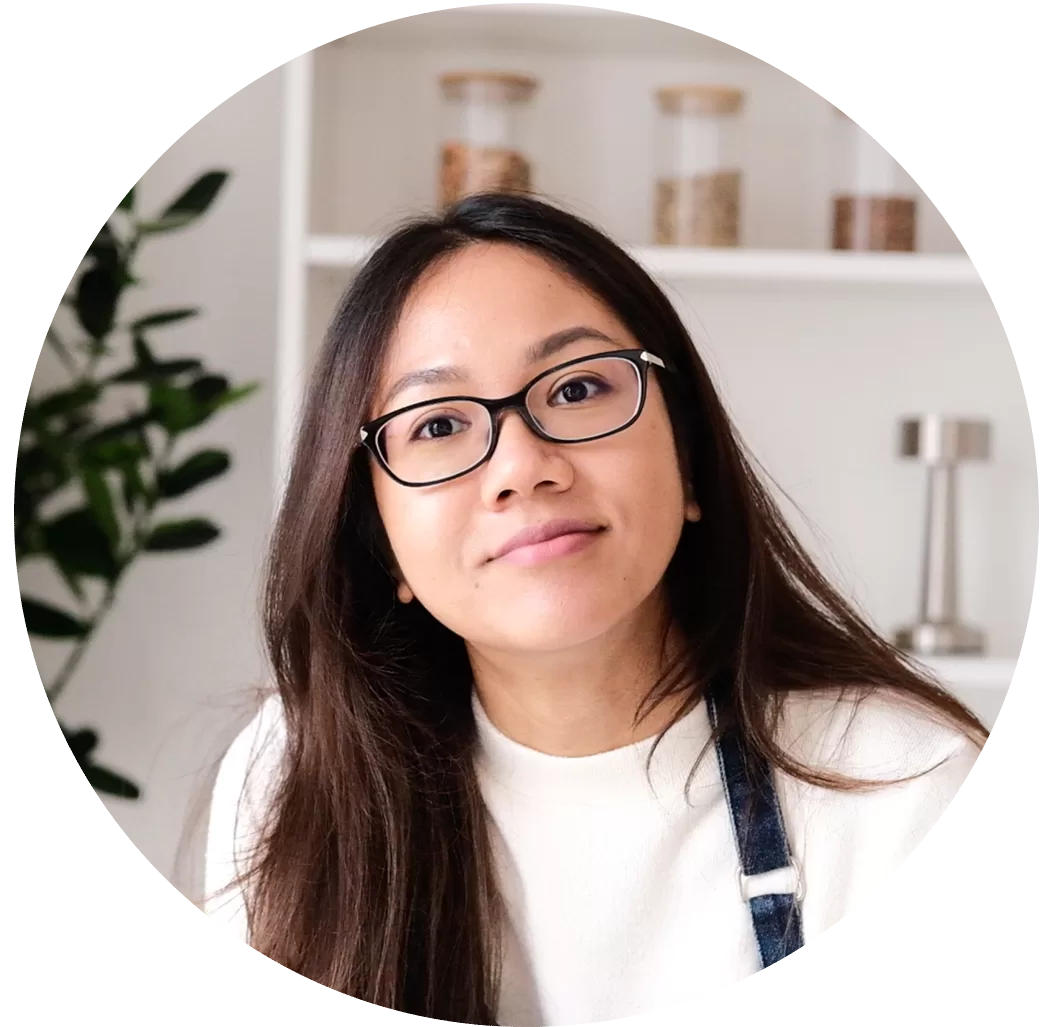
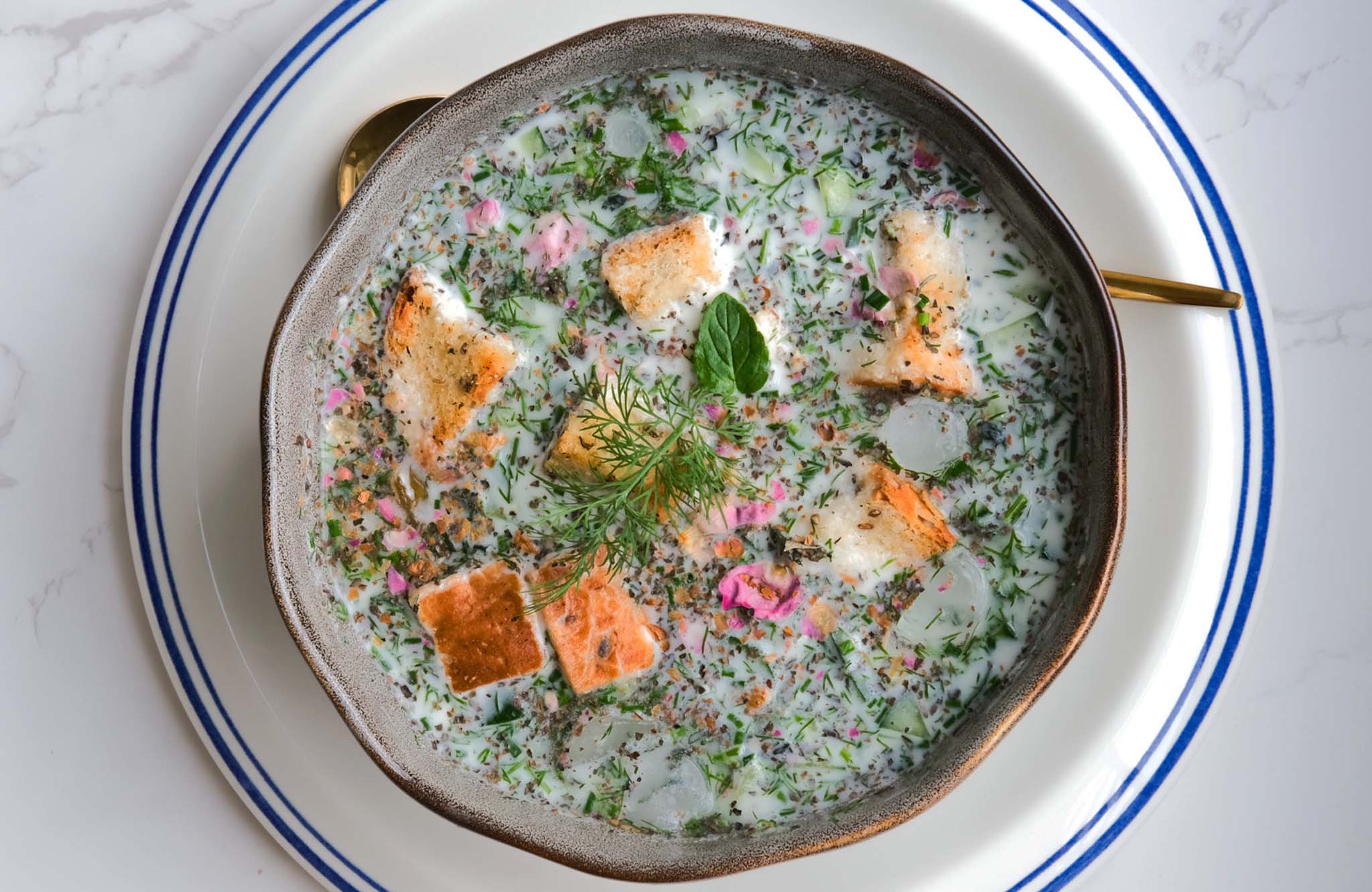
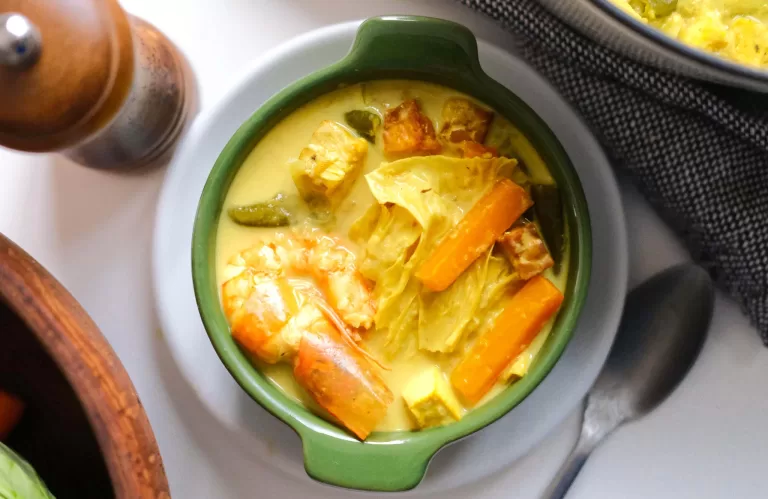






One Response
I tried this recipe and it turned out great! Thanks!